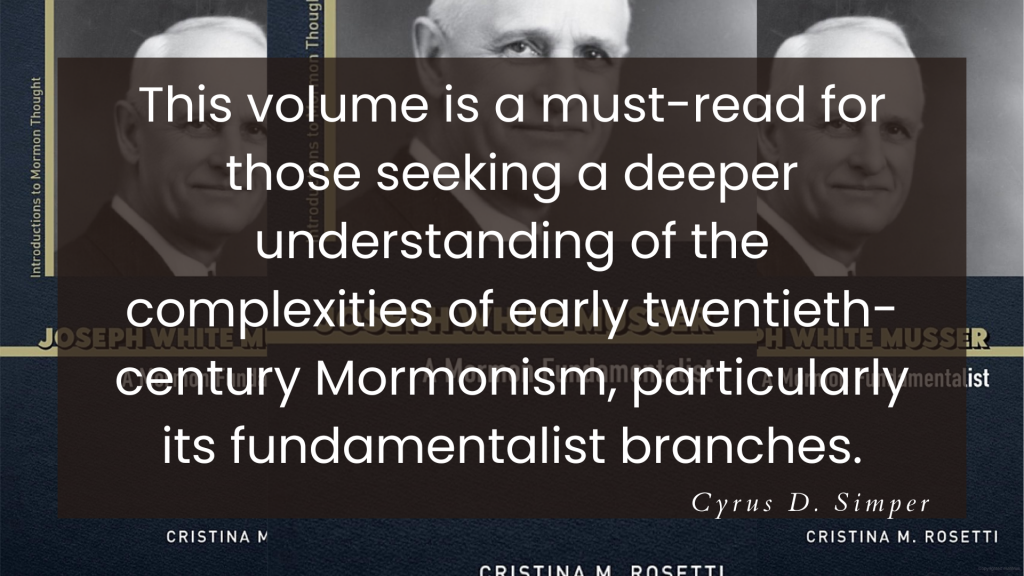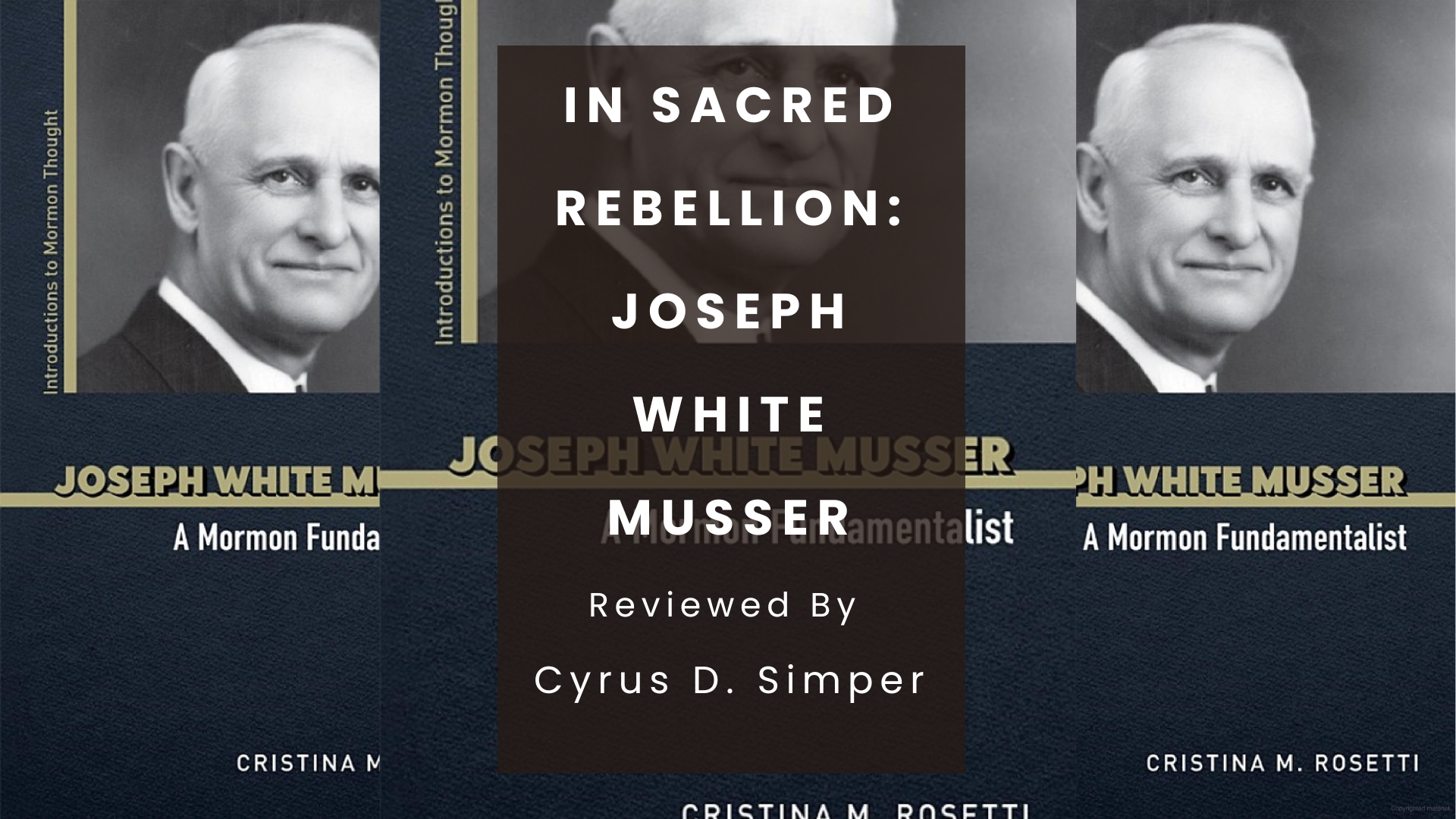Articles/Essays – Volume 58, No. 2
In Sacred Rebellion: Joseph White Musser | Cristina Rosetti, Joseph White Musser: A Mormon Fundamentalist
Cristina Rosetti’s Joseph White Musser: A Mormon Fundamentalist provides a comprehensive and analytically rich examination of Musser’s life and theology, delving into his influential role in one of the more schismatic periods of Mormon history. The author’s critique of scholars’ overemphasis on the institutional perspective and her argument for a more balanced approach that recognizes the pivotal role of individual players in Mormon thought add a fresh perspective to the field. Throughout her monograph, the reader is invited to explore what it means to be part of the broader restorationist revisionist movement that made up early twentieth-century Mormonism. This volume is a must-read for those seeking a deeper understanding of the complexities of early twentieth-century Mormonism, particularly its fundamentalist branches.
Rosetti’s work is thematically structured, offering a multifaceted analysis of Musser’s life and doctrinal innovations. She begins with a biographical narrative, tracing Musser’s formative years, his ascent within Church leadership, and his eventual excommunication. This biographical foundation sets the stage for a nuanced examination of Musser’s theological contributions and his persistent advocacy for what he viewed as the foundational principles of the Mormon faith. It contextualizes them within the broader sociopolitical milieu of his time, underscoring the significance of his life and work in the context of Mormon fundamentalism.
Rosetti provides a comprehensive narrative of Musser’s life, emphasizing his unwavering commitment to faith and eventual divergence in the face of institutional change. Born in 1872, Musser was raised in a devout Mormon family. Musser was one of thirty-five children, and polygamy was an intrinsic part of his religious identity. This upbringing profoundly influenced his spiritual development and theological perspectives.
In 1892, Musser married Rose Wimmer, and seven years later, the couple received the second anointing, a sacred ritual believed to bestow the highest spiritual blessings. Despite the spiritual bond they shared, Musser’s increasing advocacy for polygamy, amid ongoing legislative and Church opposition, strained their marriage. This personal struggle, along with his familial responsibilities, often intersected with his commitment to his faith, influencing his decisions and theological stances. Rosetti’s detailed account of these personal and spiritual conflicts humanizes Musser and adds depth to his character.
Musser remained a fervent advocate for “celestial” or plural marriage, viewing it as a divine commandment and a cornerstone of Mormon theology despite the Church’s recurrent renunciations of polygamy. He believed that the 1890 Manifesto, commonly called the “To Whom It May Concern” statement, did not apply to him or other high-ranking Church officials, as evidenced by their post-Manifesto plural marriages. His steadfast support for the principle eventually led to his excommunication in 1921. This period was highly influential, as changing teachings on celestial marriage created a doctrinal divide between the Church and its members, underscoring the enduring tensions between traditionalist and reformist factions.
Much of the book is dedicated to Musser’s role in the study group criminalized under President Grant and comprised of those disillusioned with broader Church narratives. Selected individuals from that study group would later form the Council of Friends under the direction of Lorin Woolley. Rosetti’s detailed analysis of Musser’s defense of celestial marriage provides important insights into the theological and cultural underpinnings of the fundamentalist movement and its resistance to the government. Rosetti also explores the Church’s push to end the practice both publicly and privately, writing that it was “as much a matter of reputation and embarrassment as a matter of policy and obedience (24).”

Rosetti examines the doctrinal disputes and personal conflicts that emerged in the wake of Musser’s leadership. The tensions between Musser and others, such as John Y. Barlow and Joseph Lyman Jessop, are presented with a nuanced understanding of the theological and sociopolitical factors at play. This section of the book provides valuable insights into the complexities of religious leadership and the challenge of maintaining unity within a dissident religious movement. Her examination includes a discussion of Musser’s writings and sermons, which grew to articulate the significance of the second anointing in achieving spiritual exaltation and maintaining the integrity of the priesthood.
Musser’s economic views and advocacy for a United Order form another focal point of the volume, as Rosetti explores his financial difficulties and critiques of the US monetary system, which he believed were ultimately incompatible with the principles of the restored gospel. In the last chapter, she examines Musser’s promotion of the United Order, a system of communal living and economic consecration, within his broader theological framework. Rosetti highlights Musser’s writings on tithing and the formation of the United Effort Plan, emphasizing these foundational principles as vital to early fundamentalist theology. These principles, she argues, allowed participants to survive and navigate their treacherous economic environment.
Throughout the book, Rosetti situates Musser within the broader historical and sociopolitical context of Mormonism, particularly during the turbulent period surrounding the Church’s renunciation of polygamy. She meticulously examines the legislative pressures and internal conflicts that shaped Musser’s beliefs and actions, offering a nuanced understanding of the complex environment in which he operated. The book relies on a diverse array of primary and secondary sources, including Musser’s journals, letters, and contemporary accounts. Rosetti’s adept navigation of the available materials allowed her to present a detailed portrayal of Musser’s life and thoughts. Her inclusion of direct quotations and personal reflections from Musser enables readers to engage deeply with his experiences and theological perspectives.
While Rosetti’s work is thorough, expanded analysis of certain topics would be welcome. Further work could elaborate on President Heber J. Grant’s centralization of second anointings and its impact on the stratification of authority within the Church. Additionally, a deeper exploration of Musser’s relationships with his contemporaries in the Council of Friends would provide a more holistic understanding of his motivations and connections with his eventual successors. Perhaps Weber’s theory of routinization of charisma could enhance this analysis.
Overall, Rosetti’s book is essential for anyone interested in the history of Mormon fundamentalism. Her meticulous research and engaging narrative shed light on the complexities of Musser’s life and his enduring influence on Mormon thought. Her analysis offers a critical lens through which to explore the intersections of theology, authority, and social change, making the book a pivotal text for ongoing discussions in the field by sociologists, theologians, and historians alike.
Cristina Rosetti. Joseph White Musser: A Mormon Fundamentalist. Urbana: University of Illinois Press, 2024. Paper: $14.95. 128 pp. ISBN: 978-0-252-08775-2.


 Back to full Issue
Back to full Issue

